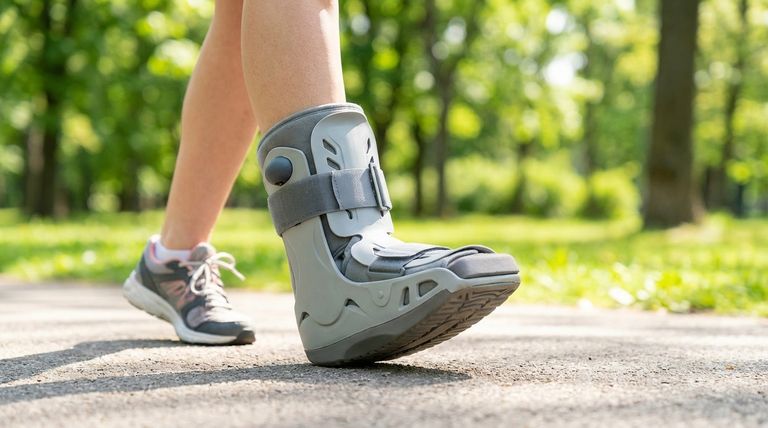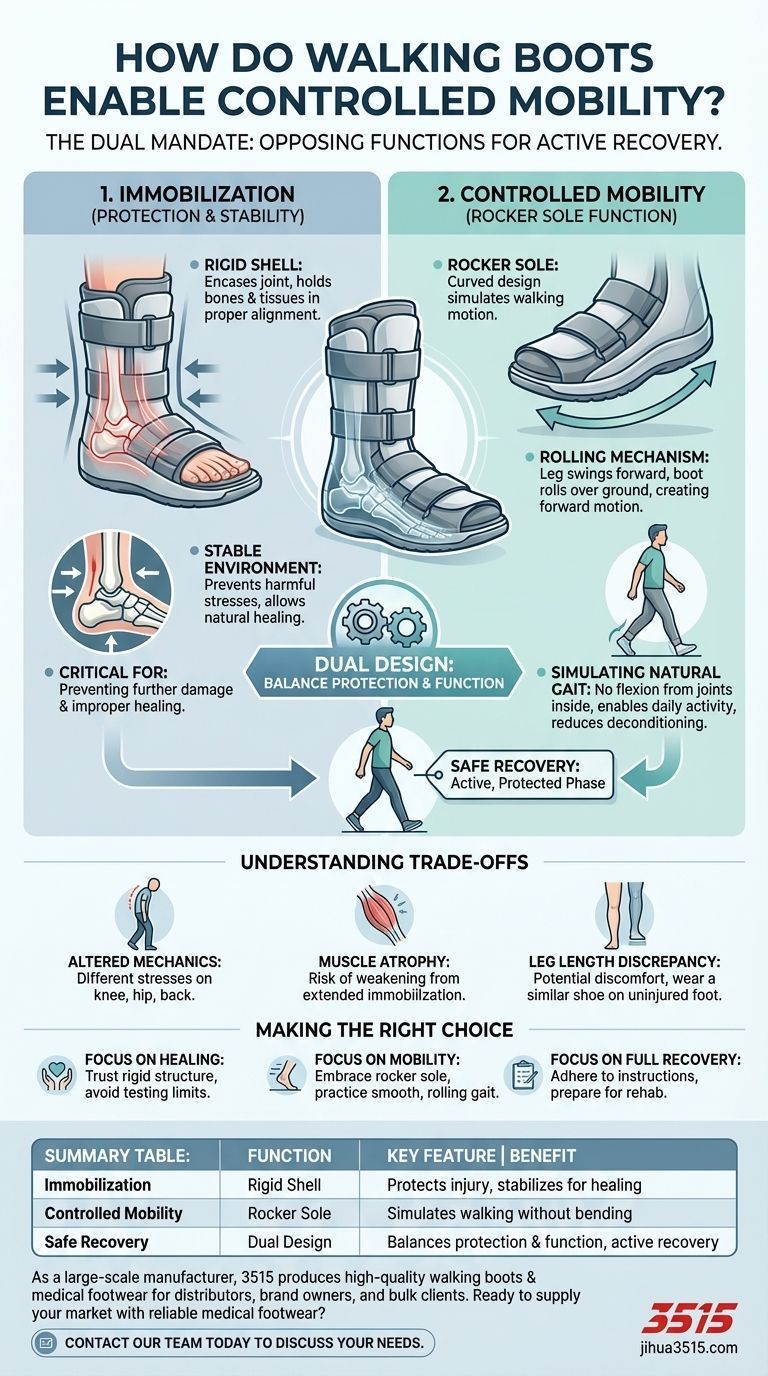At its core, a walking boot enables controlled mobility by combining two opposing functions. It rigidly immobilizes the injured foot and ankle to protect it, while its specially designed rocker-bottom sole allows you to simulate a walking motion without bending the injured area.
The genius of a walking boot lies in its dual design: a protective, rigid shell for immobilization and a curved "rocker" sole that allows the leg to roll forward, creating mobility without compromising the healing of the foot or ankle.

The Dual Mandate: Protection and Function
A walking boot must first and foremost protect the injury. It achieves this by creating a stable environment where damaged tissues can heal without being subjected to harmful stresses or movements.
The Foundation: Rigid Immobilization
A walking boot’s primary job is to provide stability and severely restrict movement in the foot and ankle. This is the "immobilization" part of the equation.
By encasing the joint in a rigid structure, the boot holds the bones and soft tissues in their proper alignment. This stability is critical for allowing the body's natural healing process to work effectively.
Why Immobilization is Critical
This enforced stillness prevents further damage to the injured area. It minimizes the risk of complications, such as a fracture not setting correctly or a ligament healing in a lengthened position, which could lead to chronic instability.
The Key to Mobility: The Rocker Sole
While immobilization is crucial for healing, complete lack of movement is impractical. The boot's design cleverly solves this by changing how you walk.
How the Rocker Sole Works
The most important feature for mobility is the curved, thick sole, known as a rocker sole. This design is not flat like a normal shoe.
Instead of your foot and ankle bending to propel you forward, the curved sole allows you to "rock" from your heel to your toe. Your leg swings forward, and the boot rolls over the ground, creating forward motion.
Simulating a Natural Gait
This rolling mechanism mimics the general pattern of a normal walking gait but without requiring any flexion from the joints inside the boot. This allows you to engage in necessary daily activities, reducing the deconditioning that comes from being completely sedentary during recovery.
Understanding the Trade-offs
While effective, a walking boot is a medical compromise. Its design introduces necessary limitations and potential side effects that you should be aware of.
Altered Body Mechanics
The rocker sole simulates walking, but it does not replicate it perfectly. The lack of natural ankle and foot movement can place different stresses on your knee, hip, and even your lower back.
Risk of Muscle Atrophy
Keeping your ankle and foot immobilized for an extended period will inevitably lead to some weakening and loss of muscle mass in your lower leg. This is why physical therapy is often a critical component of recovery after the boot comes off.
Leg Length Discrepancy
The thick sole of a walking boot can create a slight difference in leg length, which can contribute to discomfort in the hips and back. Wearing a shoe with a similar sole height on your uninjured foot can often help mitigate this issue.
Making the Right Choice for Your Goal
Using a walking boot effectively means understanding its purpose and working with its design, not against it.
- If your primary focus is healing: Trust the boot's rigid structure. Avoid any movements that test its limits, as its stability is what allows your injury to mend properly.
- If your primary focus is safe mobility: Embrace the rocker sole. Practice a smooth, rolling gait to move efficiently and minimize compensatory strain on your other joints.
- If your primary focus is a full recovery: View the boot as a temporary tool. Adhere strictly to your doctor's instructions on its use and be prepared for rehabilitation to regain strength and flexibility afterward.
Ultimately, the walking boot is an engineering solution that transforms a period of static healing into a phase of active, protected recovery.
Summary Table:
| Function | Key Feature | Benefit |
|---|---|---|
| Immobilization | Rigid Shell | Protects injury, stabilizes bones and tissues for proper healing |
| Controlled Mobility | Rocker Sole | Simulates walking motion without bending the injured area |
| Safe Recovery | Dual Design | Balances protection and function, enabling active, protected recovery |
As a large-scale manufacturer, 3515 produces a comprehensive range of high-quality walking boots and medical footwear for distributors, brand owners, and bulk clients. Our production capabilities ensure durable, effective designs that support controlled mobility and optimal patient recovery. Ready to supply your market with reliable medical footwear? Contact our team today to discuss your specific needs and discover how we can support your business.
Visual Guide

Related Products
- Custom Wholesale Leather Safety Boots Direct Factory Manufacturing
- Premium Wholesale Waterproof Safety Boots High Performance Protection for Industrial Markets
- Customizable Anti-Smash Safety Boots for Wholesale & Private Label Manufacturing
- Premium Grain Leather Safety Boots for Bulk Supply
- Durable Rubber-Soled Utility Shoes for Wholesale & Custom Brand Manufacturing
People Also Ask
- What are the differences between steel toe, composite toe, and alloy toe Wellington boots? Choose the Right Safety Toe for Your Job
- Is safety toe better than steel toe? A Guide to Choosing the Right Protection
- What is a safety-toe in a boot? Your Guide to Choosing the Right Protection
- Do moc toe boots have steel toe? Get Durable, Safety-Compliant Footwear
- What's the difference between safety toe and steel toe? Choose the Right Protective Footwear.



















